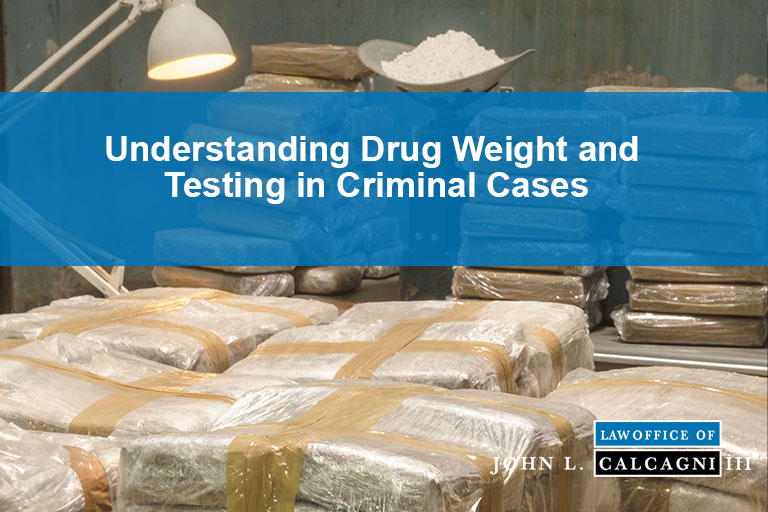Understanding Drug Weight and Testing in Criminal Cases

Drug weight and testing are important factors when evaluating criminal charges for drug crimes. The weight of an illegal narcotic may determine if the charged crime(s) is a misdemeanor or a felony. Drug weight may also be considered a mitigating or aggravating factor when deciding upon the appropriate punishment for someone convicted of a drug crime. Testing is conducted to determine drug type.
Contents
- Field Testing: The First Step in Drug Crime Investigations
- Gross vs. Net Weight: Key Measurements in Drug Prosecutions
- Chemical Analysis: Identifying and Confirming Drug Types
- The Role of Adulterants in Drug Trafficking and Their Impact on Legal Cases
- Misconceptions About Drug Purity in Criminal Prosecutions
- Challenging Laboratory Findings in Drug Cases
- Seek Legal Assistance for Drug Crime Charges
Field Testing: The First Step in Drug Crime Investigations
When police seize suspected narcotics in connection with a criminal case or narcotics investigation, they first perform a field test of the substance to quickly confirm or dispel suspicions that it is an illegal drug.
Though these field tests are not 100% reliable, they are widely used and relied upon by law enforcement agencies throughout the country to make arrest and probable cause determinations. If a substance field tests positive for an illegal drug, it is seized and sent to a laboratory for chemical analysis.
Gross vs. Net Weight: Key Measurements in Drug Prosecutions
Upon receipt of drug evidence, laboratory technicians weigh the substance. First, they calculate gross weight of the seized evidence, which includes both the substance and packaging material in which narcotics ae contained.
Next, they remove all packaging materials in order to weigh only the actual narcotics resulting in a net weight. Net weight is less than gross weight, and only relates to the quantity of a narcotic, opposed to drugs plus packaging materials.
Net weight is the measure used in criminal prosecutions to make charging decisions and to prove crimes. Net weight is also the measure relied upon by courts when imposing criminal sentences in drug cases.
Chemical Analysis: Identifying and Confirming Drug Types
Once drug evidence is properly weighed, it is then tested to analyze its chemical composition, which analysts use to determine drug type. Examples of drug types include cocaine, heroin, fentanyl, and more.
Analysts typically subject the substance to two forms of testing. The initial form of testing identifies the chemical composition to determine drug type.
The second form of testing is a more sensitive, confirmatory test to verify the drug type. This two-step process enhances the reliability and accuracy of the overall drug testing process, and reduces any potential margin of error.
The Role of Adulterants in Drug Trafficking and Their Impact on Legal Cases
Most illegal drugs are mixed or cut with one or more other substances, called adulterants, before being sold for consumption. Drug dealers do this to expand the volume of their product, which increases profit, and also to reduce the potency of a drug.
For example, when a kilogram of cocaine is imported into the United States, it may be 50% pure, having already been cut one time.
Once purchased by drug traffickers, additional cut may be added to expand the volume of the kilogram from one to two or more kilograms, which again reduces potency. This process continues as drugs are sold in smaller quantities down the line, until they reach the actual drug user(s).
Misconceptions About Drug Purity in Criminal Prosecutions
The purity or potency of a drug is not an important consideration in criminal drug prosecutions. Many criminal defendants are misinformed in this regard, mistakenly believing that purity is the key to their defense, or somehow that low purity levels can be relied upon to reduce drug weight or lessen criminal responsibility.
Most criminal statutes outlawing the possession, distribution, manufacturing, or trafficking of illegal narcotics due to not speak to the purity or potency of the substance. Rather, the law bans any substance or mixture containing a detectable amount of an illegal drug.
Legislators understood the cutting and mixing of drugs with adulterants by drug traffickers. Hence, they wrote the law in a way that aims to hold defendants accountable for the full quantity of the drug, once cut or mixed, they intended to possess, manufacture, or distribute in violation of the law. No sentencing credit, benefit, or rewards are available in cases involving impure illegal narcotics.
Challenging Laboratory Findings in Drug Cases
Some criminal defendants may seek to challenge laboratory findings in criminal drug cases. Challenges may be made to drug type and weight findings. A defendant may either ask the prosecution, or file a motion with the Court directing that drug evidence be retested and/or reweighed.
A defendant may also retain his or her own expert to be present for the retesting or reweighing procedure to oversee or monitor the process. Such challenges seldom lead to any significant findings that can be used to successfully defend drug charges. However, this option of retesting and reweighing may be available upon request.
Seek Legal Assistance for Drug Crime Charges
If you are charged with a drug crime and have questions about the drug weight or testing process in your case, contact Rhode Island Drug Crime Defense Lawyer, John L. Calcagni III, at (401) 351-5100.
